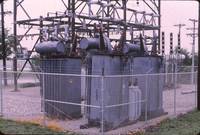Current Gallery: substationsswitchyards ( piece)
The monumental scope of America's power system is portrayed in two highly visible aspects of a utility's investment: transmission and distribution. However, at intermediate points, facilities are required to transform voltages and current from transmission lines, to control and confirm these changes as the energy is further refined and converted for commercial, industrial and residential use. These facilities are called switchyards and substations. Switchyards may increase or reduce voltages, but more often they perform a "switching" purpose and provide a means to instrument and control transmission lines feeding in and out of their locations. Substations are defined as locations where higher voltages are substantially reduced from transmission to sub-transmission or sub-transmission to distribution levels. Both have overcurrent and overvoltage protection, switching abilities and command and control aspects, such as instrumentation for Supervisory Control and Data Acquisition (SCADA). The history of substation architecture is as old as the introduction of early power transmission itself in the 1880s. Early substations were enclosed in buildings, but later--as the result of their size and voltage clearance requirements--installed at open air sites. Here we assemble a number of colorful images portraying both modest and immense facilities all around the United States.
The monumental scope of America's power system is portrayed in two highly visible aspects of a utility's investment: transmission and distribution. However, at intermediate points, facilities are required to transform voltages and current from transmission lines, to control and confirm these changes as the energy is further refined and converted for commercial, industrial and residential use. These facilities are called switchyards and substations. Switchyards may increase or reduce voltages, but more often they perform a "switching" purpose and provide a means to instrument and control transmission lines feeding in and out of their locations. Substations are defined as locations where higher voltages are substantially reduced from transmission to sub-transmission or sub-transmission to distribution levels. Both have overcurrent and overvoltage protection, switching abilities and command and control aspects, such as instrumentation for Supervisory Control and Data Acquisition (SCADA). The history of substation architecture is as old as the introduction of early power transmission itself in the 1880s. Early substations were enclosed in buildings, but later--as the result of their size and voltage clearance requirements--installed at open air sites. Here we assemble a number of colorful images portraying both modest and immense facilities all around the United States.





